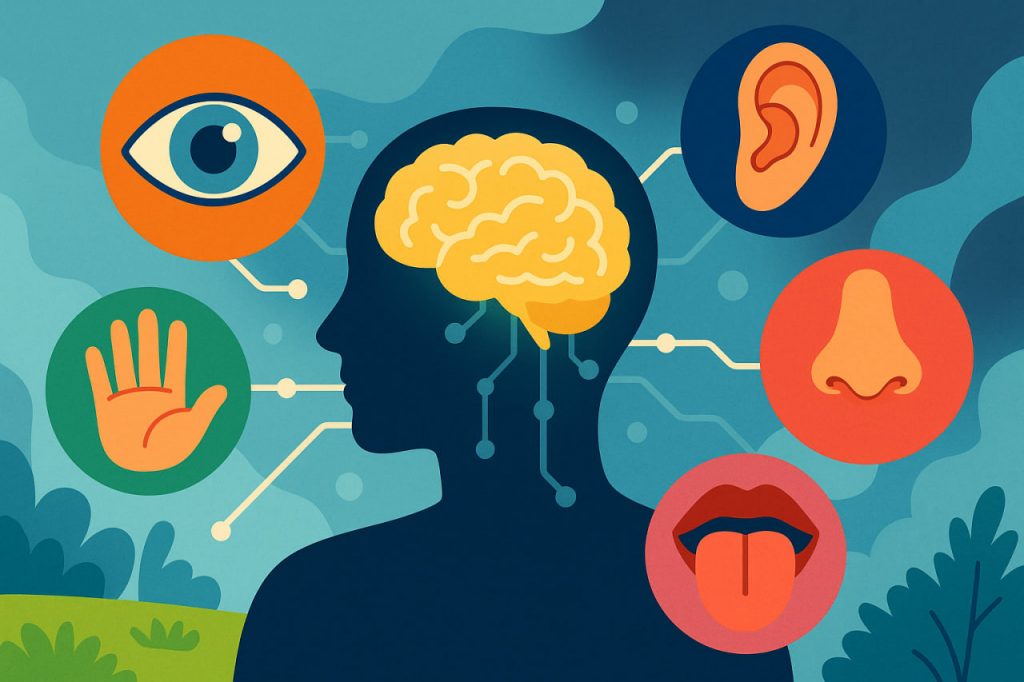Every second, the human brain receives an immense amount of information — colors, sounds, smells, textures, and tastes. Yet what we perceive as “reality” is not simply what exists outside of us, but how our senses and mind interpret it. Our perception is a creative process: it transforms physical signals from the environment into meaningful experiences that shape how we understand the world, interact with others, and make decisions.
The Role of the Five Senses
Humans primarily perceive the world through five main senses — sight, hearing, touch, taste, and smell. Each sense provides a different type of information, which the brain combines into a single coherent picture of reality.
- Sight (Vision)
The eyes capture light waves reflected from objects. These waves are converted into electrical signals by the retina and transmitted to the visual cortex in the brain, where shapes, colors, and movement are recognized. Vision allows us to navigate our surroundings and understand spatial relationships. - Hearing (Audition)
Sound waves travel through the air and enter the ear, vibrating the eardrum and tiny bones that send the vibrations to the cochlea. The auditory nerve then carries the signals to the brain, which interprets them as speech, music, or environmental sounds. - Touch (Somatosensation)
The skin is filled with sensory receptors that detect pressure, temperature, and pain. Touch connects us physically to the world and emotionally to others — from feeling warmth to sensing danger. - Smell (Olfaction)
Molecules in the air enter the nose and stimulate receptors in the olfactory bulb, which sends signals to the brain’s limbic system — the center of emotion and memory. This is why certain scents can instantly trigger strong memories or feelings. - Taste (Gustation)
Taste buds on the tongue detect five primary flavors — sweet, sour, salty, bitter, and umami (savory). Combined with smell, taste shapes our experience of food and influences appetite and pleasure.
Beyond the Traditional Senses
Modern neuroscience has revealed that we actually have more than five senses. Among them are:
- Proprioception — the sense of body position and movement.
- Equilibrioception — the sense of balance, controlled by the inner ear.
- Thermoception — the ability to feel temperature.
- Nociception — the sense of pain.
- Chronoception — our awareness of time passing.
These additional senses work subconsciously but are essential for coordination, survival, and self-awareness.
How the Brain Builds Reality
Our senses do not simply record the world — the brain interprets signals based on memory, emotion, and expectation. This means that perception is subjective: two people can experience the same event differently.
For example, a song may evoke joy in one person but sadness in another, depending on their personal history. Optical illusions and auditory tricks also show that the brain fills in missing details and sometimes “sees” things that aren’t really there.
This process of active interpretation allows humans to adapt to changing environments but also shows how fragile and limited our perception can be.
The Role of Emotion and Attention
Perception is deeply influenced by emotion and focus. When we are happy, the world seems brighter; when anxious, it feels threatening. The brain filters information according to what we find important — this is why we can hear our name in a noisy room or miss obvious details when distracted.
Attention acts as a spotlight, selecting what we notice and what fades into the background. Our worldview is therefore shaped not by everything we encounter, but by what we pay attention to.
Artificial and Enhanced Perception
Modern science is expanding human perception through technology:
- Telescopes and microscopes allow us to see the universe and atoms.
- Infrared cameras detect heat invisible to the human eye.
- Hearing aids and cochlear implants restore sound perception.
- Virtual and augmented reality create digital worlds that the brain experiences as real.
These tools extend our senses, allowing us to explore parts of existence that were once completely hidden.
Interesting Facts
- Humans can distinguish over 10 million colors but only about 5 basic tastes.
- The brain processes visual images about 60,000 times faster than words.
- Smell is the only sense directly linked to the memory center of the brain.
- Babies explore the world primarily through touch and taste, while adults rely mostly on sight.
- In space, astronauts experience a shift in perception because gravity no longer helps them orient their bodies.
Glossary
- Sensory receptors — specialized nerve endings that detect external stimuli.
- Olfactory bulb — brain region responsible for processing smells.
- Proprioception — awareness of body position and movement.
- Cortex — the outer layer of the brain that processes sensory information.
- Perception — the brain’s interpretation of sensory input to form a conscious experience.


